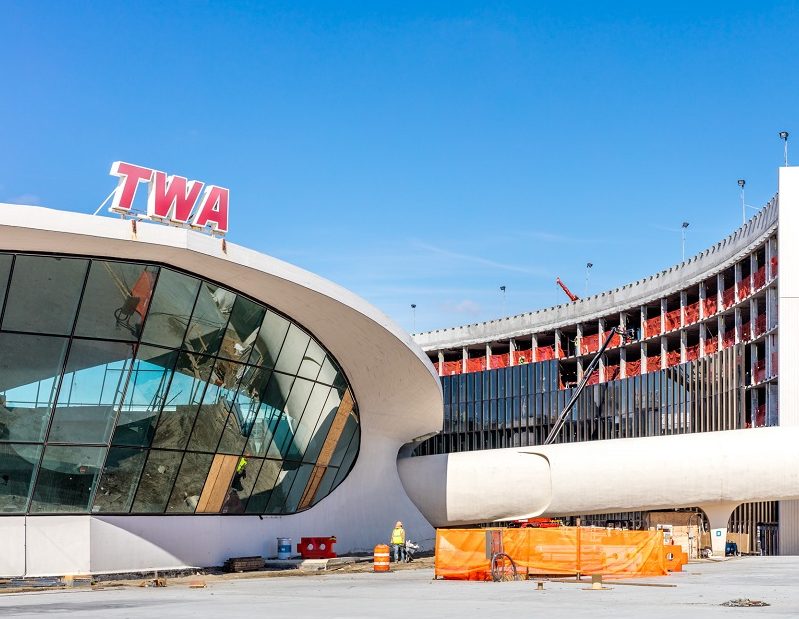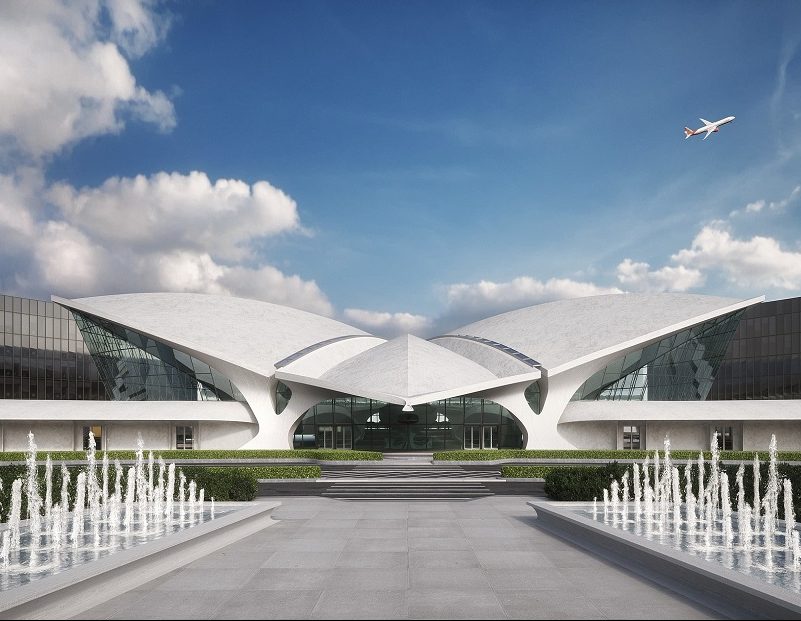Cogeneration Takes Flight at JFK Airport Hotel
The adaptive reuse of a landmark airport terminal will incorporate a cost-effective combined heat and power plant.
By Diana Mosher

The TWA Hotel at JFK International Airport in Queens, N.Y. (Photo by Max Tuohey/Courtesy of MCR)
When MCR Development announced in 2015 that it would be converting the TWA Flight Center at John F. Kennedy International Airport into a lobby and retail space for an adjacent six-story hotel, it was a happy day for architecture and aviation enthusiasts. Now, as the $265 million project nears completion in first quarter 2019, another aspect of the hotel is garnering additional interest: Its self-contained cogeneration power system, which will reduce the property’s operating costs by an estimated $4 million.
Most attention will focus on the existing 200,000-square-foot building, a flight-themed 1962 masterpiece designed by Eero Saarinen. That will be the hotel’s public-facing component and house the hotel’s lobby, registration desk, restaurant, bars and retail. The renovated front portion will connect to two new wings that will offer 512 guest rooms. Other visitor draws: A new conference center and a retro cocktail bar housed in a vintage plane.
Those features will lure visitors, but the remarkable power strategy will be located out of public view. Housed on the roof of the north hotel building will be a combined heat and power plant (CHP) will supply electricity and regulate temperature for the entire property. The CHP plant will connect to a natural gas source, allowing the building to operate on a separate power source from the airport and greatly reduce its energy expenses. “The CHP effectively saves us $4 million a year in operating costs,” said Jason Garone, vice president construction, MCR Development.

Rendering of the TWA Hotel at John F. Kennedy International Airport (PRNewsfoto/MCR Development)
The default decision would have been to connect to JFK’s existing cogeneration plant, which supplies power and thermal energy to terminals and support facilities. But the cost of those services seemed prohibitive.
“The CHP was the brainchild of Tyler Morse,” Garone said. Combined heat and power (CHP), also known as cogeneration, supply reliable electricity, steam and hot water at lower cost and emissions than grid-supplied electricity and an on-site boiler. Superior energy efficiency and lower energy costs resulting from CHP can earn significant points toward LEED certification.
As Garone put it: “Why not build your own power plant and you can get high-pressure gas in and produce your own power, your own thermal energy—and control your own destiny.”
The CHP plant will connect to a natural gas source, allowing the building to operate on a separate power source from the airport and greatly reduce its energy expenses. “The CHP effectively saves us $4 million a year in operating costs,” he says.
“When you get power in from Con Ed, you don’t know where that power is being produced,” adds Garone. “It could be from oil or coal. Gas is a clean energy. It burns much cleaner than some of the other fossil fuels so that’s another benefit.”
Prefabrication of the CHP using a modular system to assemble the elements off site is saving approximately six months of construction time. Rather than a traditional build-up of the main cogeneration components, its three reciprocating engines, three gas-driven chillers and boilers are being assembled in Kingston, Ontario, Canada in ten containers that have been specially fabricated.
“Those units can be sent down here and then lifted in place, one by one, and connected. You streamline your construction and have fewer crane lifts than when you build it by parts and pieces on site,” adds Garone.
“The Flight Center is the jewel in the crown. It’s the showpiece of the project and the reason why this project is happening,”







You must be logged in to post a comment.